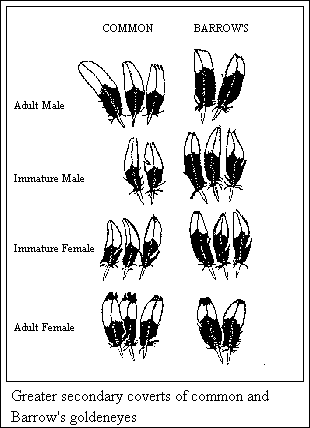Species, Age and Sex Identification of Ducks Using Wing Plumage
Separation of Common and Barrow's Goldeneyes
Species Identification
The black bases of most greater secondary coverts on Barrow's goldeneyes extend over more than half of each feather and are visible on a normally spread wing. On common goldeneyes, these black bases cover less than half of each feather and are normally hidden. Usually the outer vanes of less than 7 secondaries are white on Barrow's goldeneyes, but on common goldeneyes outer vanes of 7 or more secondaries are white.

Age and Sex Identification
Adult males of each species are sufficiently distinctive to be easily identified. Adult females of both species have a broad black band across the tips of the greater secondary coverts. Immatures of both species have greater secondary coverts with white or variably spotted tips (not banded) that are often slightly frayed. The sexes of immatures appear similar, but 95% may be identified on the basis of wing length.
Previous Section -- Separation of Greater and Lesser Scaups
Return to Contents
Next Section -- Separation of Bufflehead and Hooded Merganser

